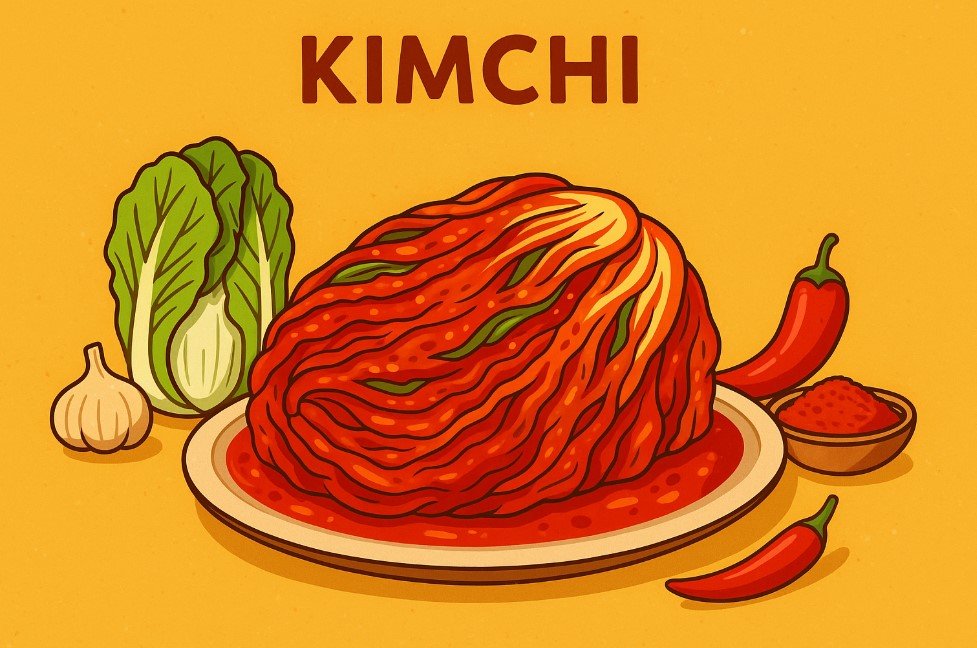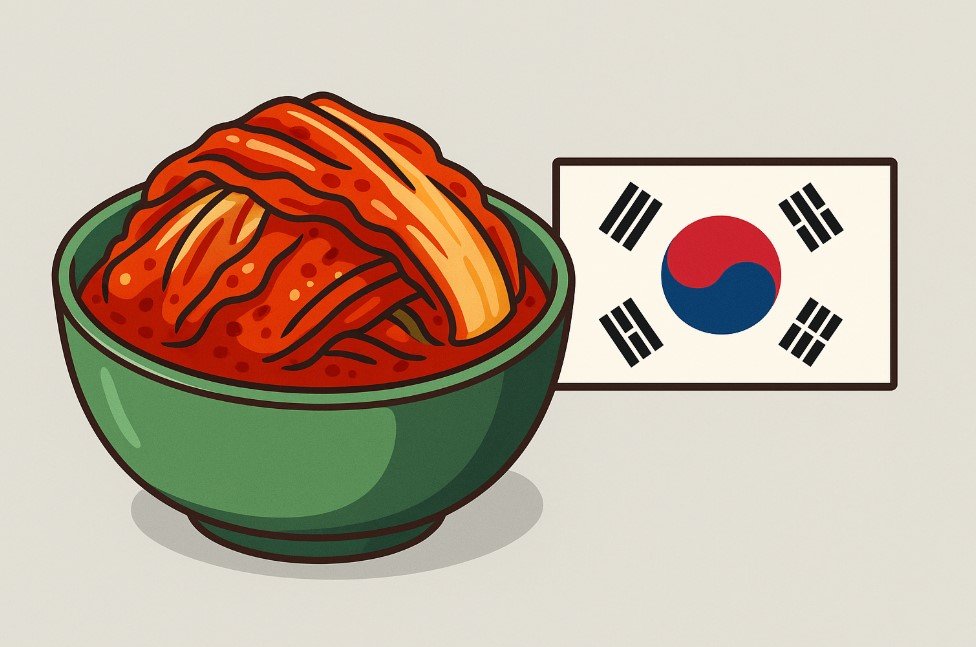Food
What is Kimchi? Ingredients, Origins, and the Secrets Behind Its Red Color

Kimchi is one of the most well-known foods in Korean cuisine. It is popular not just in Korea but also around the world. With its spicy, sour, and tangy flavour, it has become a favourite side dish and ingredient in many meals. Whether you are new to Korean food or already enjoy eating it, learning more about kimchi can help you appreciate this traditional dish even more. In this blog post, we will explain what kimchi is, what it is made of, where it comes from, and what gives kimchi its distinctive red color.
What is Kimchi?
Kimchi is a traditional Korean dish made from fermented vegetables. It is seasoned with spices and salt and left to ferment for several days or even weeks. The fermentation process gives kimchi its unique taste and texture. It can be eaten on its own, served as a side dish with rice, or added to other dishes like stews, pancakes, and fried rice.
There are many types of kimchi, but the most common version is made using napa cabbage and Korean red pepper powder. The flavour can range from mild to very spicy, depending on the recipe. Kimchi is also known for its strong smell and its ability to last a long time when stored properly.
So, if you are wondering what kimchi is, the simple answer is: it is a spicy, sour, and salty fermented vegetable dish that is deeply connected to Korean culture and cuisine.
Kimchi is a Traditional Fermented Food From Which Country?
Many people ask, Kimchi is a traditional fermented food from which country? The answer is South Korea. Kimchi has been part of Korean food culture for centuries. It is eaten daily in most Korean households and is often made in large batches to last through the year. The making of kimchi, called “kimjang”, is even recognised by UNESCO as an important cultural tradition in Korea.
Though other countries also have fermented foods, kimchi is special because of its strong link to Korean identity. It is served at almost every Korean meal and is often described as a must-have dish in Korean homes.

What is Kimchi Made Of?
A common question is What is kimchi made of? While there are many varieties of kimchi, most of them use similar core ingredients. The basic components include vegetables, salt, garlic, ginger, fish sauce, and Korean red pepper flakes called gochugaru. Let’s look at some of the main ingredients in more detail:
- Vegetables – The most important vegetable in kimchi is napa cabbage. However, other vegetables like radish, cucumber, and green onions are also used in different types of kimchi.
- Salt – Salt is used to draw out water from the vegetables. This helps with the texture and starts the fermentation process.
- Garlic and Ginger – These ingredients add strong, aromatic flavours and are commonly used in Korean cooking.
- Fish Sauce or Fermented Shrimp – These are used to deepen the flavour and add umami, though vegetarian versions also exist.
- Red Pepper Flakes (Gochugaru) – This ingredient is what gives kimchi its spicy kick and red color.
In some recipes, sugar, onions, or fruit like pears and apples are also added to balance the flavours. The ingredients are mixed, packed tightly in jars or containers, and then stored at cool temperatures to ferment.
What is the Main Vegetable Used in Traditional Kimchi?
Though many vegetables can be used in different types of kimchi, what is the main vegetable used in traditional kimchi is napa cabbage. This large leafy vegetable is ideal for fermentation because of its firm texture and mild taste. Napa cabbage holds up well during the fermentation process and absorbs the flavours of the spices very well.
Whole cabbage leaves are often salted and softened before being coated with the spice mixture. The result is a rich, tangy dish that is crunchy and full of flavour. Napa cabbage kimchi is the most common and popular version found in Korean homes and restaurants.
How is Kimchi Made? A Step-by-Step Overview
Here is a basic step-by-step guide on how traditional napa cabbage kimchi is made:

- Clean and Cut the Cabbage – The cabbage is sliced lengthwise and soaked in a saltwater solution for several hours.
- Rinse and Drain – After salting, the cabbage is rinsed to remove extra salt and then drained.
- Prepare the Paste – A paste is made using garlic, ginger, fish sauce, sugar, and gochugaru (red pepper flakes).
- Add Vegetables – Shredded carrots, green onions, and radish are often added to the mix.
- Mix and Coat – The cabbage leaves are coated with the spicy paste mixture.
- Pack in Jars – The coated cabbage is packed tightly into jars to remove air.
- Ferment – The jars are left at room temperature for one to two days, then moved to a fridge or cool area to continue fermenting for up to a week or longer.
This process gives the kimchi its unique taste and long shelf life.
What Gives Kimchi Its Distinctive Red Color?
One of the most noticeable things about kimchi is its bright red color. Many people ask, What gives kimchi its distinctive red color? The answer is the Korean red pepper flakes known as gochugaru. This spice is made from sun-dried red chili peppers and is used in many Korean dishes. Gochugaru is not only spicy but also slightly sweet and smoky. Its deep red color blends with the other ingredients to give kimchi its classic look.
Without gochugaru, kimchi would look very different and would not have the same flavour. There are some non-spicy versions of kimchi, but the traditional one almost always includes gochugaru. This ingredient is key to both the colour and taste of kimchi.
Types of Kimchi
Though napa cabbage kimchi is the most common, there are many other types of kimchi in Korean cuisine. Here are a few popular ones:
- Baechu Kimchi – Made with napa cabbage and the most traditional form.
- Kkakdugi – Made with cubed radish and has a crunchy texture.
- Oi Sobagi – Stuffed cucumber kimchi, often eaten during summer.
- Chonggak Kimchi – Made with ponytail radish and is more common in rural areas.
- White Kimchi (Baek Kimchi) – This version does not contain red pepper flakes and is mild in taste. It is popular among those who prefer non-spicy foods.
Each type of kimchi has a unique flavour and preparation method. The variety shows how flexible and creative Korean cooking can be.
Health Benefits of Kimchi
Kimchi is not just tasty; it is also very healthy. Because it is fermented, it contains probiotics which are good for gut health. These are live bacteria that help improve digestion. Kimchi is also rich in vitamins A, B, and C, as well as minerals like iron and calcium.
Other health benefits include:
- Boosting the immune system
- Reducing inflammation
- Supporting weight loss
- Lowering cholesterol levels
- Helping with blood sugar control
However, people who are sensitive to spicy foods or have certain digestive conditions should eat kimchi in small amounts.
Kimchi in Modern Cuisine
Today, kimchi is enjoyed in many ways. It is no longer just a side dish but a main ingredient in many fusion recipes. Chefs around the world use kimchi to add flavour to sandwiches, tacos, burgers, and even pizza. Some people blend it into smoothies or make kimchi pancakes and kimchi fried rice.
Its strong taste means that just a small amount can enhance the flavour of a dish. Kimchi is now sold in supermarkets around the world and is often found in health food stores as well.
Making Kimchi at Home
Making kimchi at home is easier than it seems. Many people try it as a weekend project. The ingredients are simple, and the steps can be followed with basic kitchen tools. Homemade kimchi also allows you to control the level of spice, salt, and fermentation. You can make it vegan, less salty, or more garlicky depending on your preference.
Some people buy kimchi kits that include gochugaru, fish sauce, and other key items. All you need to add are the vegetables and time.
Conclusion
Kimchi is more than just a Korean side dish. It is a part of Korean history, culture, and daily life. It is made with simple ingredients but offers deep flavour and health benefits. To recap, what is kimchi? It is a fermented vegetable dish with roots in Korea. What is kimchi made of? It usually includes napa cabbage, salt, garlic, ginger, fish sauce, and red pepper flakes. Kimchi is a traditional fermented food from which country? The answer is Korea. What is the main vegetable used in traditional kimchi? That would be napa cabbage. And finally, what gives kimchi its distinctive red color? It is the Korean red pepper flakes called gochugaru.
Whether you buy it or make it yourself, trying kimchi is a great way to enjoy something delicious and healthy. If you have never tasted it before, now is the perfect time to give it a try.
-

 Social Media2 months ago
Social Media2 months agoWhat the “67” TikTok Meme Really Means
-

 Tech2 months ago
Tech2 months agoWhat To Do When Your Business Faces Network Vulnerabilities
-

 Self Improvement2 months ago
Self Improvement2 months agoUsing BCBS Rehab to Access Quality Addiction Care
-

 Games2 months ago
Games2 months agoPusoy Strategies for Play That Also Work in Pusoy Dos in English






